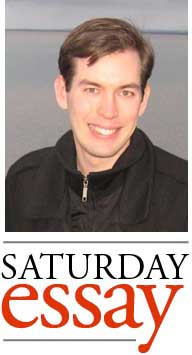Living History on Empty Streets
 “Duluth is a bit off-center, both literally and figuratively—something most Duluthians don’t seem to mind at all. After all, this is the city whose skyway system runs partially underground, where the West End is located in the city’s geographic center, and whose annual Christmas City of the North parade is held a week before Thanksgiving. Duluth may be a little bit off-center, but part of what makes Duluth Duluth is that here, true north isn’t always where you’d expect it to be.”
“Duluth is a bit off-center, both literally and figuratively—something most Duluthians don’t seem to mind at all. After all, this is the city whose skyway system runs partially underground, where the West End is located in the city’s geographic center, and whose annual Christmas City of the North parade is held a week before Thanksgiving. Duluth may be a little bit off-center, but part of what makes Duluth Duluth is that here, true north isn’t always where you’d expect it to be.”
— Tony Dierckins, Duluth: An Urban Biography
Sheltering in place gives a devotee to a city even more time to learn it intimately. I read Tony Dierckins’ new biography of Duluth, which fits the bill of a pre-founding-to-present history that I pined for on my blog some while back. The biography really only left me hungry for more: it clocks in at just under 170 pages and could easily have been double that length if it were to thoroughly explore structural forces and the lives of prominent figures beyond a series of mayors and those who crossed their paths. Still, it was a welcome step beyond Tony’s previous fun vignettes and collections, most of which peter out somewhere in the middle of the 20th century. Granted, Duluth’s history becomes somewhat less romantic in that stretch; the great turn-of-the-century wealth faded, the growth stalled, and the architecture wandered away from an eclectic opulence to something much more mundane. Still, the book is a reminder that this city’s history has always been one of awkward lurches, of rises and falls, and a quest for some sort of stability in the aftermath.
Dierckins, citing Arthur W. Baum, likens Duluth to a stumbling prizefighter. (I would have used a hockey analogy, but this one will certainly do.) This city has been battered and bloodied by history: shock after economic shock, a lynch mob that killed its diversity, leadership both bold and questionable. Only rarely has Duluth seemed in control of its own fate, as when its early residents dug the shipping canal (a much more professional and mundane process than some local legends would have you believe), or when late 20th century leadership slowly turned the city back toward first Lake Superior and later the St. Louis River as centerpieces. So often Duluth’s fortunes depend on the whims of others, or no human at all: distant creditors, the American steel industry, the shifts in transportation that came with the interstate highway system. As the coronavirus now ravages the city’s economy, we embark on yet another lurch.
And so I set out to soak up Duluth’s living, breathing history, my mental record of this moment in time. I go for a run—with the sporadic hike on an off day—every day for a month and a half, and never aim to take the same route twice. At first there was no real rhyme or reason to my wanderings, but once I realized I’d covered all but a handful of Duluth neighborhoods, I decided to knock out the rest over the span of a week and a half. I checked off the last one when I plowed up Vinland Street to Bayview Heights on a recent Sunday morning, just far enough to catch a glimpse of the promised land of Proctor across Boundary Avenue. I’m not one to track my distance religiously as I run, nor to lose myself in music or a podcast: I’m just here to run, and to drink in the world around me with my eyes.
In my adventures I find a few more off-center quirks, like the intersection of Main Street and Central Avenue tucked in next to the paper mill deep on the west side. The top of the hill, somehow, is just one monstrous swamp, enlivened by a springtime frog chorus; a few boys in Piedmont splash through the muck in pursuit of the peepers. Duluth is a college town without college neighborhoods, a tourist town whose great landmark came about thanks to some grumpy residents of a sandbar who were peeved their city built the channel that was the source of all its early wealth. One of our showpiece parks is named for an explorer who never came within a thousand miles of the place. As the wind blows, so goes my comfort, at turns frigid or sweaty, guided by a tailwind or slowed by a blast from straight ahead.
Early Superiorites derided Duluthians as cliff-dwellers, and I could see why as I shot up and down the Point of Rocks at the center of the city. I relish the punishment of the runs that just go straight up into Kenwood or the top of the hill in Woodland or up to Lincoln Middle School or that nameless bit of the hillside by the old Summit School. Even a run along the seemingly more level northeast-to-southwest axis offers up an aggressive climb over the Point of Rocks and a more subtle but equally draining rise up to the ridge at about 24th Avenue East. (It’s easier to see now why Duluth’s old money chose this bit of land to throw up its enduring monuments.) When I moved back to Duluth a few years ago, I noticed a change in my leg muscles as my then-sporadic running routine adjusted to constant slopes.
“Duluth is turning into Chicago,” someone groused to me over the phone recently as he griped about crime and undesirables. I cringed at the lack of perspective and the racial undertones, and in mild defensiveness as a Duluthian with Chicago roots. Still, my runs remind me of what a divided city Duluth can be. I witness a drug deal off Portland Square, while a woman in Endion goes through a tearful breakup on the sidewalk over the phone. A kid on the west side tries to hide his cigarette from passersby as he supervises a younger sibling in the yard. In one of the more modest corners of Duluth Heights, a teenager storms out of a house amid loud shouts, and a neighbor edges down his driveway as he looks on in worry. The coronavirus strain is evident everywhere, but most obvious in places where people have little space to escape from the others in their lives, or where they rely on tenuous networks to prop themselves up. Crises like this strain the threads of our social fabric, and the thicker the weave, the better.
Jane Jacobs’ world is in a coma: all social life is now intentional. Downtown takes on a new bleakness without its weekday street life, middling as it may be. Lincoln Park is as dead as it was fifteen years ago, the virus bringing a sad reversion to a lifeless state in which I only pass two other people on the streets, both of whom may live on the streets. Around Denfeld I brush up against a certain charm, a bit dated but comfortable, pride still evident in most quarters, a sense that we’ll be back to normal before long. Old corner stores lurk here and there, most now turned to small houses, leaving a sense of what commerce was like in decades past. Fairmount and Irving inspire different reactions as I cruise through them in a sunny snow squall: a corner of the world aging away, lost to time, or at least any seeming need to keep up with it. Part of me is sympathetic, but the rules of the real estate game are rather less forgiving.
I oversimplify. Morgan Park, that fascinating time capsule, spawns new life in a giant townhome project rising into being on the site of its former school. Down the street, a kid blasts away at puck after hockey puck, and calls out a forlorn, human-contact-craving greeting as I pass. Whatever Gary’s giant trailer park may be, it is not old or tired, and that neighborhood’s industrious residents keep adding new features to the public land next to Stowe school. On the day I head down Highway 23 clear out to Chambers Grove Park, the westernmost tip of the westernmost city on the Great Lakes, a diverse, socially-distanced smattering of people explores the site of Duluth’s earliest settlement here at the base of the dalles of the St. Louis.
The classic narrative pits Duluth’s divides in a battle of east versus west, but anyone who knows the city well knows it’s more complicated. The real dividing line, if there is one, is east of center, maybe starting at Chester Creek and fully turning over at 21st Avenue East. But even that is an oversimplification. Duluth is a city of pockets, of unexpected streets that dodge their ways up hills that I’m still finding after years and years of exploration. I find blocks in my native Lakeside I never knew existed, serene riverfront homes in the far west, new twists in Kenwood, and come across a little of everything up in the Heights. A pocket of Piedmont has more McMansions than I knew Duluth could hold, this neighborhood much more divided between new construction and stellar views on the south side of its eponymous avenue and aging bungalows on the north side than I ever knew. Nothing is uniform.
Even on the east side blocks I’ve now run countless times, there’s more to explore. I suss out the different gradations of Lakeside and Woodland, see which blocks fit my vibe more than others. Still, the relative lack of an edge in the lands beyond Endion is apparent. On a socially distanced walk around Chester Park, a friend and I muse on the east side bubble we inhabited as children, our impression of Duluth as a haven of Subaru-driving cross-country skiers, its most glaring disruptions in the exploits of some hockey players or the antics of some college students up the street. I grew up thinking rich people live in grand old Congdon or London Road estates, not McMansions off cul-de-sacs in swamps over the hill, and my taste will probably always reflect that bias. I’ve come to believe that sensibility is a very Duluth attitude: a little maintenance probably required, but worth the effort, more capable of inspiring genuine loyalty and rootedness, not just the disposable products of a liquid modernity. Taste, intricacy, detail, and maybe some subtlety lurk in these woods.
My runs provide a vivid reminder: this city is old, an age all the more obvious with fewer current residents out and about. Of course in the grand scheme Duluth is young, hundreds of years younger even than so-called cities of the future like San Francisco or Los Angeles. Perhaps it’s more accurate to say we live history more here because we have less of the new. Duluth has seen glory and its loss, the narrative arc one needs to tell a good story, and the evidence is all around us if we know where to look for it. Relics of different eras abound: grand old Endion homes converted to apartments, empty thoroughfares like pre-freeway Cody Street, the downtown areas where property values tend to push toward either renovation or demolition to keep the engines going. Duluth’s rebellion against totalizing trends requires upkeep, requires care, requires knowing when something is beyond any further practical use and might be better off just fading back into the hillsides.
Nowhere in Duluth do worlds collide more than on Observation Hill, that steep incline just west of downtown dotted with staircases to nowhere and crumbling foundations, the remains of a past Duluth that sprung up along the Point of Rocks and set some of its first foundations here. My first memories of the city are from atop this hill—my mom lived here, briefly, while my dad tidied up affairs in southern Wisconsin before we moved here for good when I was six—and a quarter century later, it still feels like some realm of mystery for a child to explore. A few incongruous modern homes now lord over parts of this hillside, sharing space with some hardscrabble rowhouses and a smattering of aging urban farmers with Bernie signs still lurking in their yards. Here is Duluth in all its complicated glory, past and future and wealth and poverty all intertwined, all on a stunning perch over the most superior of lakes. Duluth’s budgets may rise and fall, and economic forces it cannot control may drive its prosperity or its struggles, but it will always have that view, and because of that it will always have its allure.
Duluth loyalists, however, can’t coast on allure alone. I come back to the prizefighter analogy: we need to learn to scrap again, to believe in a place not just for what it has been but what it can be. I admire the sentiment that we all just get along, and the all-in-this-together solidarity that a pandemic inspires. But Duluth arose not through gentility but by a dose of raw ambition that made such future leisure possible. The coronavirus is as good a reminder as any that we can’t hide from history, that it will come for us all at some point or another, and we can only run for so long. If Duluth is to continue punching above its weight, we children of a city freighted with history should know we have a role to play.
Karl Schuettler spits out occasional thoughts on A Patient Cycle, a blog that offers his take on a perfectly logical combination of topics such as Duluth-area affairs, the exploits of high school kids playing hockey, experiments in fiction, and anything else that wanders into his head.
Recommended Links:
Leave a Comment
Only registered members can post a comment , Login / Register Here














No Comments